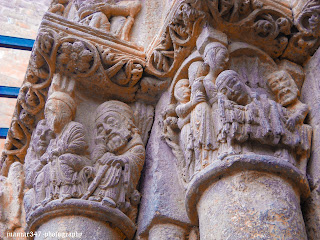¿Piedra, papel, tijera o piedra, enigma y metáfora? / Rock, paper, scissors or rock, enigma and metaphor?
Por alguna razón que no ha sido nunca lo suficientemente
explicada y por lo tanto, queda sujeta a la demanda de todo tipo de especulaciones,
a Aymeric Picaud, el cronista y autor de la primera guía de ese conjunto de
itinerarios y claves mistéricas, que es, no cabe duda, el Camino de Santiago,
se le podría considerar como el primer anti navarro de la Historia. Y, sin
embargo, Navarra, desde los tiempos de Picaud y sus bajas calificaciones,
continúa siendo una tierra fértil, hermosa y singular, sutilmente rica en un
Patrimonio Histórico, Artístico y Cultural, que, desde luego, no deja a nadie
indiferente. Esto se hace mucho más patente, aun, si cabe, en legendarias
ciudades, que, como Estella, al cabo de los siglos continúan conservando unas
claves mistéricas, que atraen considerablemente la atención, no sólo por la
belleza de una arquitectura, la Románica, que fue, desde luego, pródiga en esta
tierra de pan y vino, como por el magnetismo intrínseco que se desprende de una
escultura, en cuyas trazas se podría adivinar la poderosa fuerza de unas manos,
anónimas y magistrales, que ya dejaron antes la calidad de su huella, en lugares
como Jaca, Huesca o las Cinco Villas aragonesas.
Esto se hace más patente, de cualquier manera, si, alejándonos de las mediáticas singularidades del centro urbano de la ciudad, con las legendarias referencias al épico combate entre Roldán y el gigante Ferragut, consignado en el singular Palacio de los Reyes de Navarra, bajo la atenta vigilancia de ese otro hito para el peregrino, que es la iglesia de San Pedro de la Rúa, ascendemos, fatigosamente, hacia la parte alta de la ciudad y nos detenemos frente a ese exquisito poema en piedra, que, no les quepa ninguna duda, es la magnífica portada de la iglesia de San Miguel. Una portada, frente a cuya sorprendente visión, no nos sería difícil, en absoluto, meternos por un momento en la piel de aquél cabalístico caballero de la Mancha, Don Quijote, y ver, a través de ese sutil velo que separa la frontera de la objetividad de esa otra tierra de fantasía, que es la metáfora, gigantes, que, adoptando la posición de la mitológica Esfinge, nos retan a enfrentar el combate cultural de descifrar lo que realmente se oculta detrás de cada uno de sus innumerables detalles.
For some
reason that has never been sufficiently explained and is therefore subject to
the demand of all kinds of speculations, to Aymeric Picaud, the chronicler and
author of the first guide to that set of itineraries and mysterious keys, which
is There is no doubt that the Saint James Way could be considered the first
anti-Navarrean route in history. And yet, Navarra, since the times of Picaud
and his low qualifications, continues to be a fertile, beautiful and unique
land, subtly rich in Historical, Artistic and Cultural Heritage, which, of
course, leaves no one indifferent. This becomes much more evident, even, if
possible, in legendary cities, which, like Estella, over the centuries continue
to preserve mysterious keys, which attract considerable attention, not only for
the beauty of the architecture, the Romanesque, which was, of course, lavish in
this land of bread and wine, as if by the intrinsic magnetism that emerges from
a sculpture, in whose traces one could guess the powerful force of hands,
anonymous and masterful, who had already left the quality before of its mark,
in places like Jaca, Huesca or the Five Villages of Aragon.
This
becomes more evident, in any case, if, moving away from the media singularities
of the urban center of the city, with the legendary references to the epic
combat between Roland and the giant Ferragut, recorded in the unique Palace of
the Kings of Navarra, under the attentive surveillance of that other landmark
for the pilgrim, which is the church of San Pedro de la Rúa, we ascend,
tiringly, towards the upper part of the city and we stop in front of that
exquisite poem in stone, which, no matter what Without a doubt, it is the
magnificent façade of the church of Saint Michael. A cover, in front of whose
surprising vision, it would not be difficult for us, at all, to put ourselves
for a moment in the skin of that cabalistic knight of La Mancha, Don Quixote,
and see, through that subtle veil that separates the border from the objectivity
of that other fantasy land, which is the metaphor, giants, who, adopting the
position of the mythological Sphinx, challenge us to face the cultural combat
of deciphering what is really hidden behind each of its innumerable details.
AVISO: Tanto el texto, como las fotografías que lo
acompañan, son de mi exclusiva propiedad intelectual y por lo tanto, están
sujetos a mis Derechos de Autor.
NOTICE:
Both the text and the accompanying photographs are my exclusive intellectual
property and are therefore subject to my Copyright.









Comentarios